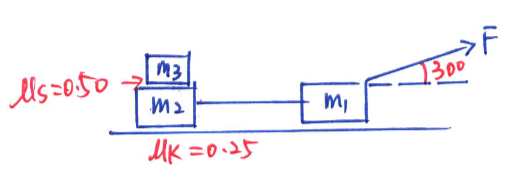M1 is connected to M2 with a rigid string. Both sits on a leveled ground of uk=0.25 with M3 sitting on top of M2. When a force F 25 N pulls on M1 forward with an angle 30.0 degrees with respect to the ground, all three blocks move at the same acceleration. (M1= 3.0 kg, M2=2.0 kg, M3=1.0 kg) a. draw a free body diagram of each block, b. what is the normal force and friction on M1 ? c. what is the acceleration of the system (M1+M2+M3)? d. use work and Kinetic theory to find the speed of the system at the time all blocks have traveled a displacement of 5.0 m.
M1 is connected to M2 with a rigid string. Both sits on a leveled ground of uk=0.25 with M3 sitting on top of M2. When a force F 25 N pulls on M1 forward with an angle 30.0 degrees with respect to the ground, all three blocks move at the same acceleration. (M1= 3.0 kg, M2=2.0 kg, M3=1.0 kg) a. draw a free body diagram of each block, b. what is the normal force and friction on M1 ? c. what is the acceleration of the system (M1+M2+M3)? d. use work and Kinetic theory to find the speed of the system at the time all blocks have traveled a displacement of 5.0 m.
College Physics
11th Edition
ISBN:9781305952300
Author:Raymond A. Serway, Chris Vuille
Publisher:Raymond A. Serway, Chris Vuille
Chapter1: Units, Trigonometry. And Vectors
Section: Chapter Questions
Problem 1CQ: Estimate the order of magnitude of the length, in meters, of each of the following; (a) a mouse, (b)...
Related questions
Question
M1 is connected to M2 with a rigid string. Both sits on a leveled ground of uk=0.25 with M3 sitting on top of M2. When a force F 25 N pulls on M1 forward with an angle 30.0 degrees with respect to the ground, all three blocks move at the same acceleration. (M1= 3.0 kg, M2=2.0 kg, M3=1.0 kg)
a. draw a free body diagram of each block,
b. what is the normal force and friction on M1 ?
c. what is the acceleration of the system (M1+M2+M3)?
d. use work and Kinetic theory to find the speed of the system at the time all blocks have traveled a displacement of 5.0 m.

Transcribed Image Text:ch.7
Ms=0.50
M3
M₂
MK = 0.25
M₁
TI
F
1300
Expert Solution
Step 1: Determine the given data:

Step by step
Solved in 6 steps with 7 images

Knowledge Booster
Learn more about
Need a deep-dive on the concept behind this application? Look no further. Learn more about this topic, physics and related others by exploring similar questions and additional content below.Recommended textbooks for you

College Physics
Physics
ISBN:
9781305952300
Author:
Raymond A. Serway, Chris Vuille
Publisher:
Cengage Learning

University Physics (14th Edition)
Physics
ISBN:
9780133969290
Author:
Hugh D. Young, Roger A. Freedman
Publisher:
PEARSON

Introduction To Quantum Mechanics
Physics
ISBN:
9781107189638
Author:
Griffiths, David J., Schroeter, Darrell F.
Publisher:
Cambridge University Press

College Physics
Physics
ISBN:
9781305952300
Author:
Raymond A. Serway, Chris Vuille
Publisher:
Cengage Learning

University Physics (14th Edition)
Physics
ISBN:
9780133969290
Author:
Hugh D. Young, Roger A. Freedman
Publisher:
PEARSON

Introduction To Quantum Mechanics
Physics
ISBN:
9781107189638
Author:
Griffiths, David J., Schroeter, Darrell F.
Publisher:
Cambridge University Press

Physics for Scientists and Engineers
Physics
ISBN:
9781337553278
Author:
Raymond A. Serway, John W. Jewett
Publisher:
Cengage Learning

Lecture- Tutorials for Introductory Astronomy
Physics
ISBN:
9780321820464
Author:
Edward E. Prather, Tim P. Slater, Jeff P. Adams, Gina Brissenden
Publisher:
Addison-Wesley

College Physics: A Strategic Approach (4th Editio…
Physics
ISBN:
9780134609034
Author:
Randall D. Knight (Professor Emeritus), Brian Jones, Stuart Field
Publisher:
PEARSON